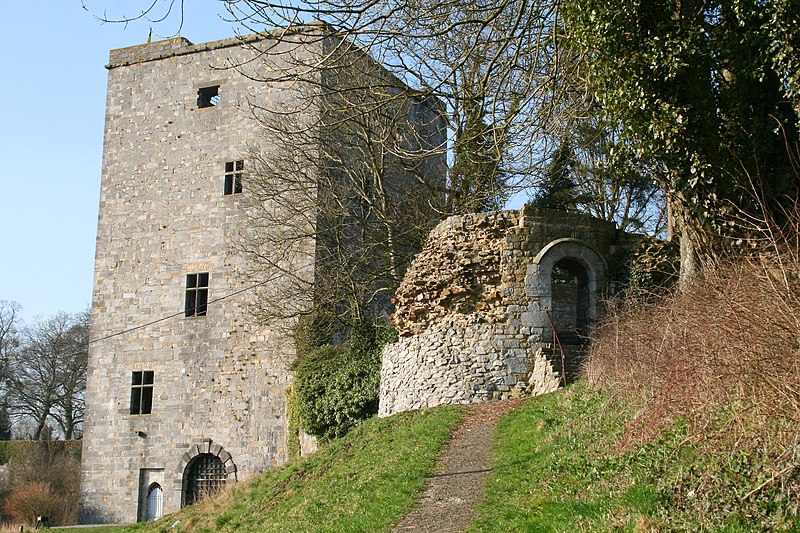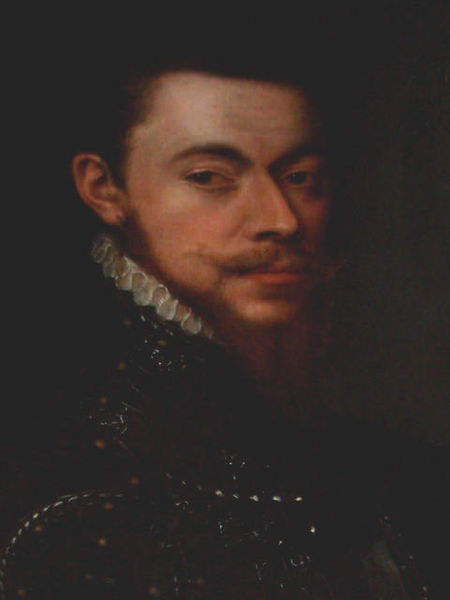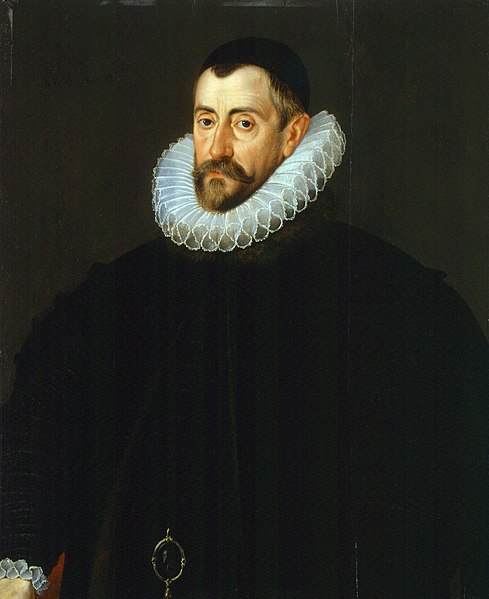 |
| Tour Salamandre, Beaumont |
Conflicting Ambitions
William had
hoped that Emperor Rudolf would support his brother Matthias as Governor of the
Netherlands. But support from the Holy Roman Emperor was sadly lacking. The
rebels were saved by a dispute in the Spanish camp which delayed an attack on
Brussels sufficiently that Matthias, the Estates General and the town council
of Brussels could be moved to Antwerp out of harm’s way.
The
Spaniards decided to overrun the southern provinces first; Parma’s troops took Beaumont, Nivelles, Chimay, Philippeville, Limburg and Dalhem. On 29th May 1578 the
Calvinist minority on the Estates General voted to accept an offer from John Casimir[i], a Calvinist freebooter and soldier
of fortune, to turn around Dutch fortunes. William did not feel that the
actions of the irresponsible Casimir would reconcile the Catholic majority in
the country to the rebels’ ambitions.
In June 1578
the Duke of Anjou, with a train of favourites, guards and servants arrived in
Mons with the offer of 10,000 infantry and 3,000 cavalry and a guarantee of
freedom of conscience. In contrast to the lack of help from Emperor Frederick,
this looked like manna from heaven. Anjou was also considering a renewal of his
courtship of the queen of England.
The English Embassy
 |
| Count of Schwartzburg-Arnstadt |
Charlotte
was pregnant again and on 31st July 1578 she gave birth in Antwerp
to her third child, Caterina Belgica. The Estates General, John Casimir
and Aunt Catherine were Caterina’s godparents. Casimir gave his goddaughter a
miniature of himself while the Estates General endowed her with a dowry.
Catherine
and William had very little time together; he was too busy trying to hold the
provinces together and unify both Calvinists and Catholics[ii]. Charlotte visited him as
often as she could, but looking after all her children and stepchildren took up
most of her attention.
Charlotte
also had care of John of Nassau’s son Philip, whom William called Flipchen,
one of Maurice’s closest friends. John of Nassau was, in part, taking the place
of Louis as William’s confidant[iii]. William’s sister Catherine and her husband the Count of Schwartzburg-Arnstadt also spent a lot of time with her
brother whenever possible.
 |
| Sir Francis Walsingham |
In August
William met with an embassy from England which included Elizabeth’s spymaster Sir Francis Walsingham and Baron Cobham, Warden of the Cinque Ports, who had long been an advocate of
intervention in the Netherlands. Amongst all his other problems, William was
unable to devote much time to the English envoys, but when he unbent Walsingham
wrote;
‘The more I deal with him,
the more sufficient I find him.’[iv]
The embassy
failed as Elizabeth’s instructions bore no resemblance to the problems on the ground,
any more than those of the Estates General who wanted the English to delay
intervention until Don Juan departed from the scene.
An Excess of Religion
On 1st
October 1578 Don Juan died from typhoid, naming` Parma as his successor in the
Netherlands. Parma continued his policy of separating the Walloon provinces
from the Calvinist dominated north. His agents got a positive response from
burghers and countrymen, particularly around Ghent, fearing the excesses of
John Casimir. who was considering replacing William as the head of the rebels.
.jpg/426px-Johann_Casimir_(Pfalz).jpg) |
| John Casimir |
Encouraged
by Casimir, Calvinist mobs attacked Catholics in Bruges, Antwerp and Brussels. William
travelled to Ghent where the Calvinists had stormed the prison and hung an
elderly man whose only crime was that he was a Catholic. William hoped to
isolate the minority trouble makers;
‘In places where popular
feeling runs high some few, relying on the natural ardour of the people, will
thrust them into doing things which infringe the common duties which we owe to
each other…..but experience has taught me that this number is very small.’[v]
He was able
to isolate Casimir and the other troublemakers. Casimir took himself off to
England where he was given a loan from Queen Elizabeth for £40,000[vi] to pay for 11,000 men.
Queen Elizabeth considered Casimir;
‘A prince for all respects
to be so acompted of, that that may part may think itself happy to whose
succours he shall be pleased to incline.’[vii]
Elizabeth
also agreed to underwrite loans for the estates general to the value of
£100,000[viii]. Elizabeth’s unusual
extravagance was encouraged by her advisers who fully believed that embroiling
Philip in the war with the Dutch would discourage him from turning his eye on
England.
Dramatic Changes
_-_PPL-9173.tif/lossy-page1-466px-thumbnail.tif.jpg) |
| Admiral Maximilien de Henin-Lietard |
On 23rd
January 1579 the Union of Utrecht was signed uniting Holland, Zealand,
Friesland, Utrecht and Guelderland under the leadership of the Prince of
Orange. Parma had signed the Union of Arras on 6th January, whereby the southern provinces of
Hainault and Artois, the towns of Orchies, Douai and Lille and the bishopric of Cambrai committed their loyalties to Spain. The provinces were now split down
lines of religious influence for the foreseeable future.
Early 1579
saw changes in the military line-up; one of William’s strongest supporters, Admiral Maximilian de Hénin-Liétard, Count of Boussu, commander
of the Sea Beggars and William’s chief of staff, died in late December 1578. The English volunteers
were also causing problems, their insubordination likely to infect the whole
army.
William
appointed one of the French volunteers François de la Noue[ix] to replace Hénin-Liétard. La Noue
did his best to root out the problems; soldiers were pillaging the countryside
for food, drunkenness was common and prostitutes were thick on the ground. He
did his best but without the subsidies from the Estates General, was unable to
stop the rot.
 |
| Francois de la Noue |
February
1579 saw Parma’s troops outside Antwerp’s walls. Parma opened the attack on 1st
March; the defenders, including the foreign volunteers, fought ferociously and
eventually Parma withdrew, unable to operate on extended supply lines. March
brought more Calvinist influenced riots in Ghent and Haarlem. Hendrik Laurenzoon Spiegel, a writer and poet from Amsterdam
wrote bitterly;
‘They who at first asked no
more than to live in freedom, Now have their liberty but will not give it to
others.’[x]
To cap it
all the Estates General refused to vote more monies to William to continue the
fight.
Spanish Triumph
Parma
marched to Maastricht and laid siege to the town. He had 20,000 men as
opposed to the garrison of 1,200. William begged the Estates for monies to go
to the relief of Maastricht, monies which were refused but came with the offer
of the Antwerp town guard. An exhausted William informed them;
‘Do as you will, but do not
blame me when Maestricht falls.’[xi]
_met_storm_verovert%2C_den_29_july_des_jaars_1579_(Jan_Luyken%2C_1679).jpg/748px-De_stadt_Maastricht%2C_door_den_prins_van_Parma_(Alexander_Farnese)_met_storm_verovert%2C_den_29_july_des_jaars_1579_(Jan_Luyken%2C_1679).jpg) |
| Siege of Maastricht |
The
Spaniards entered the town on 29th June, while the exhausted
defenders were asleep; they looted the town for three days with extreme
violence while Parma was in bed suffering from a fever.
Despite the
many obstacles in his path William managed to firm up the front line and the
Spanish were stopped from entering Brabant and Flanders. William also had to
overcome Parma’s propaganda, claiming that William alone was stopping a
peaceful resolution to the discord between peoples and sovereign.
On 28th
July the Estates General heard an anonymous petition denouncing William.
William, whose refusal to defend himself against calumnies had slowly been
winning the PR war, told the Estates that they could either have his
resignation or they would have to back him. The entire Estates General
protested their devotion to the cause and backed William, if not to the hilt,
then enough for his purposes.
It was now
that William decided to throw his political weight behind the Duke of Anjou.
The Archduke Matthias was a lightweight, hiding in William’s shadow. He brought
no support, no monies and no soldiers. Anjou on the other hand had his
brother’s support, he had money and he was prepared to pay for military prowess
to carve out a principality of his own.
Bibliography
The Age of
Religious Wars – Richard S Dunn, Weidenfeld & Nicholson 1971
The Revolt
of the Netherlands – Pieter Geyl, Cassell History 1988
Walsingham –
Alan Haynes, Sutton Publishing 2004
The Spanish
Inquisition – Henry Kamen, Phoenix 1998
Philip of
Spain – Henry Kamen, Yale University Press 1998
The Spanish
Armada – Colin Martin and Geoffrey Parker, Guild Publishing 1988
The Grand
Strategy of Philip II – Geoffrey Parker, Yale University Press 1998
Elizabeth –
Anne Somerset, Phoenix Giant 1999
William the
Silent – CV Wedgewood, Readers Union Ltd 1945
www.wikipedia.en
[i]
Younger brother of the Elector Palatine
[ii]
William’s toleration of Catholicism was looked on askance not only by the
Calvinists but also his own family
[iii]
Most of the male Nassau family of both generations became heavily involved in
the revolt
[iv]
Walsingham – Haynes
[v]
William the Silent - Wedgewood
[vi]
In 2014 the relative: historic
opportunity cost of
that project is £10,410,000.00 labour cost of that project is £134,400,000.00 economic
cost of that project is
£3,608,000,000.00 www.measuringworth.com
[vii]
Elizabeth - Somerset
[viii]
In 2014
the relative: historic opportunity cost
of that project is £26,030,000.00 labour cost of that
project is £336,000,000.00 economic cost of that
project is £9,020,000,000.00 www.measuringworth.com
[ix]
Later to write in captivity his Discours Politiques
et Militaires, published in 1587
[x]
The Revolt of the Netherlands - Geyl
[xi]
William the Silent - Wedgewood
No comments:
Post a Comment
Note: only a member of this blog may post a comment.